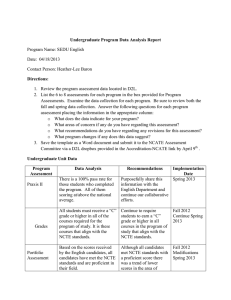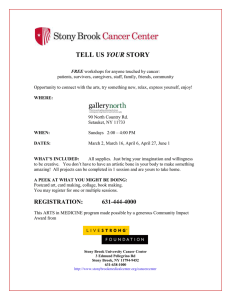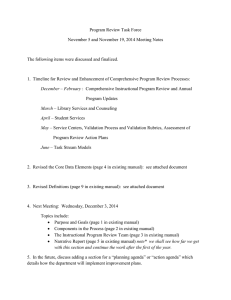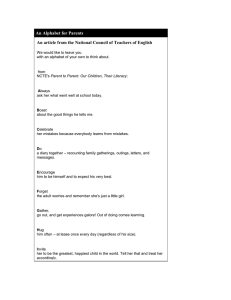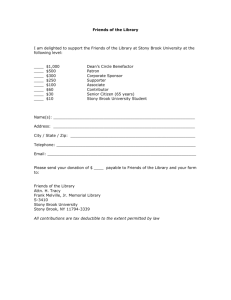Professional Education Program English Student Teacher Candidate
advertisement
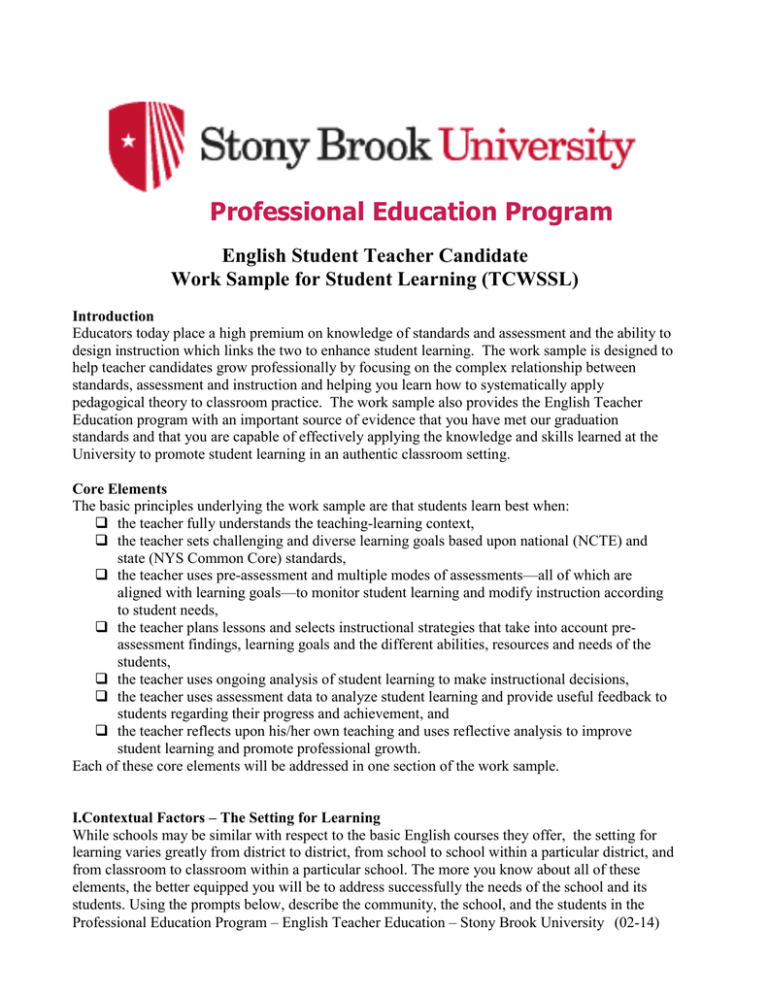
Professional Education Program English Student Teacher Candidate Work Sample for Student Learning (TCWSSL) Introduction Educators today place a high premium on knowledge of standards and assessment and the ability to design instruction which links the two to enhance student learning. The work sample is designed to help teacher candidates grow professionally by focusing on the complex relationship between standards, assessment and instruction and helping you learn how to systematically apply pedagogical theory to classroom practice. The work sample also provides the English Teacher Education program with an important source of evidence that you have met our graduation standards and that you are capable of effectively applying the knowledge and skills learned at the University to promote student learning in an authentic classroom setting. Core Elements The basic principles underlying the work sample are that students learn best when: the teacher fully understands the teaching-learning context, the teacher sets challenging and diverse learning goals based upon national (NCTE) and state (NYS Common Core) standards, the teacher uses pre-assessment and multiple modes of assessments—all of which are aligned with learning goals—to monitor student learning and modify instruction according to student needs, the teacher plans lessons and selects instructional strategies that take into account preassessment findings, learning goals and the different abilities, resources and needs of the students, the teacher uses ongoing analysis of student learning to make instructional decisions, the teacher uses assessment data to analyze student learning and provide useful feedback to students regarding their progress and achievement, and the teacher reflects upon his/her own teaching and uses reflective analysis to improve student learning and promote professional growth. Each of these core elements will be addressed in one section of the work sample. I.Contextual Factors – The Setting for Learning While schools may be similar with respect to the basic English courses they offer, the setting for learning varies greatly from district to district, from school to school within a particular district, and from classroom to classroom within a particular school. The more you know about all of these elements, the better equipped you will be to address successfully the needs of the school and its students. Using the prompts below, describe the community, the school, and the students in the Professional Education Program – English Teacher Education – Stony Brook University (02-14) classroom where the work sample unit will be taught. You will be asked to synthesize and apply the information from Section I under Section II.B below I.Contextual Factors – The Setting for Learning (3-6 pages) While schools may be similar with respect to the basic social studies courses they offer, the setting for learning varies greatly from district to district, from school to school within a particular district, and from classroom to classroom within a particular school. The more you know about all of these elements, the better equipped you will be to address successfully the needs of the school and its students. Using the prompts below, describe the community, the school, and the students in the classroom where the work sample unit will be taught. You will be asked to synthesize and apply the information from Section I under Section II.B below. A. Community Describe the community and explain how its characteristics may impact teaching and learning. You should focus on: the school district (i.e., its location, number of schools, communities included in the district, etc.) the socio-economic (home prices, income, stability) and ethnic/racial profile of the community student demographics (total number of students enrolled in the district, projected trends in student enrollment, the percentage classified as special education/504, and the percentage of ESL students and their level of English proficiency) the resources of the district and its support of education (include expenditure per pupil for general education and special education) the performance of the school on state assessments, including: a) percent of high school students earning a diploma b) percent of students scoring above 65 and 85 on the global history and geography and the US history Regents tests c) performance on 8th-grade assessments (if conducted by the district) Much of this information can be found in the report cards issued yearly for each school. These are available at https://reportcards.nysed.gov/. Additional information about community demographics and school funding, including information on high needs districts, can be found at http://www.p12.nysed.gov/stateaidworkgroup/. B. School, Classroom, and Individual Students Describe the school (size, organization plan, ability grouping, scheduling patterns, disciplinary policies, etc.) Describe the physical layout of the classroom(s) in which you are teaching, whether the classroom(s) are shared with other teachers, the technology and other resources available Describe the classroom climate and any issues relating to student behavior. What is the size and gender balance of the class(es) in which you will be teaching the material included in the work sample. How many students in these classes are special education or 504 students? What modifications are required for these students? What is the overall level of English proficiency? How many students in these classes are ELLs? Professional Education Program – English Teacher Education – Stony Brook University (02-2014) II. Learning Goals The work sample focuses on the decision-making processes involved in the planning and delivery of a 2-week unit of standards-based instruction. The unit itself should consist of a sequence of interrelated lessons which are organized around a limited number (4-6) central learning goals and which provide the students with the factual knowledge, concepts, and skills necessary to understand these key issues. In a 9th-grade English class, for example, "The Language of Advertising" would be an appropriate topic for a unit. The big ideas around which this unit could be organized might include: “What are different form of advertising and how do they use written, visual, and oral language differently?” “What rhetorical appeals run through all advertisements and why do they work?” “What advertisements are the most successful and why?” “How are ads created and market tested?” “Why are written ads able to break rules of standardized English?” These big ideas essentially raise interpretive questions for which there is no single, correct answer. They provide the overarching framework for the unit and connect the individual lessons. A. Learning Goals should focus on specific English Language Arts concepts which students will need in order to make a reasoned judgment concerning the big ideas of the unit. For example, in this unit on the Language of Advertising, important learning goals might be: “List the features of advertisements on television, radio, newspaper, and the Internet.” “List as many rhetorical appeals as possible.” “Conduct an informal survey among your friends to determine which products they purchase and then examine the ads for those products.” “Create an ad for a fictional product and market test it.” “List the forms of language use in common ads that break rules of standardized English. How are these language uses different from what is expected in formal settings?” In most cases, more than one lesson will be required to fully explore the individual learning goals. B. Relevance of Prior Knowledge and Experience for Planning: Instructional decision-making should be based on knowledge of the students, their prior academic learning, and the experience, values, preconceptions, and misconceptions that they bring from their homes and community. For two of your lessons, write a paragraph—based on the information in Section I—describing how you incorporated such knowledge into your lesson planning. You might wish to consider such issues as: a)success in acquiring necessary knowledge from previous lessons, b)proficiency in reading and mastery of academic skills, c)level and type of cultural literacy, d)past experiences of students, their families, and the community, and any other relevant factors. Wherever possible, substantiate your arguments with references to scholarly literature read in your methods courses and in the core education courses [Foundations of Education (SSE 350/CEE 505); Language and Literacy Acquisition (LIN 344/544); Special Education (CEF 347/547); and Human Development (PSY 327/595)]. C. Academic Language Acquisition: Complete the Academic Language Acquisition Chart for two lessons. In the Narrative column, explain how the lesson will provide students with the opportunity to acquire the concepts and vocabulary relevant to the lesson learning goal and demonstrate their mastery of the language function. In addition, explain how instruction will be differentiated so as to take into account the different academic and reading levels of the students in the class. Professional Education Program – English Teacher Education – Stony Brook University (02-2014) Academic Language Acquisition Chart Lesson Concepts and Vocabulary Language Function(s) Addressed Narrative 1 2 … III. Assessment One you have defined your learning goals, the next task is to determine what students will have to be able to do in order to demonstrate that they have met these goals—and with what degree of proficiency. Formative assessments enable the teacher to see what students have and have not learned, to understand why students did or did not learn, and, on the basis of this knowledge, to modify instruction accordingly. Such assessments may be informal, such as student answers to teacher questions, student questions, and observation of students as they work on class activities, or formal, such as quizzes, tests, and projects. Summative assessments provide the students with an opportunity to synthesize what they have learned during the course of the unit and enable the teacher to evaluate both student learning and the effectiveness of his/her own teaching. A. Assessment Plan: The basic task for this section is to complete the Assessment Alignment Chart using the model below. This will require you to describe the activities in which students will engage in order to demonstrate their mastery of the learning goals defined above and to explain how these assessments demonstrate such mastery. Since a well-designed unit will address several 3-4 main ideas, your summative assessment should include items or tasks that will provide information about student learning with respect to the individual learning goals. Moreover, in Section V below you will be expected to quantify and analyze student learning with respect to these individual goals. Bear in mind that, if an assessment addresses more than one of these learning goals, then simply saying that Student A earned an 85 on an assessment will not be sufficient. You will need to be able to identify the parts of the assessment correlating to the individual learning goals and quantify student learning with respect to each of these learning goals. Lastly describe any accommodations required by ELLs and student IEPs or 504 plans as well as any additional adaptations to assessments that must be made for these students. B. Pre-assessment: The first component of the assessment plan should be a pre-assessment. A preassessment might be as simple as a KWL chart, or it might involve a set of carefully structured questions. The important thing is that the pre-assessment provide a baseline of prior student knowledge as it relates to your learning goals. In Section V below, you will need information from this pre-assessment to measure how much students have learned as a result of your instruction. If you choose an informal pre-assessment, you must determine in advance how student responses can be summarized or quantified in order to subsequently measure student learning. Professional Education Program – English Teacher Education – Stony Brook University (02-2014) C. Multiple Forms of Assessment: The unit plan should employ multiple forms of assessment. D. Rubric: For your summative assessment, you must devise a rubric that will clearly describe and distinguish between different levels of proficiency. Your summative assessment for the unit must include a substantive project or writing task in addition to whatever multiple choice questions you may assign. Copies of all assessments should be included in the work sample. IV. Design for Instruction Using your knowledge of the teaching-learning context and the results of your preassessment, design and teach a 2-week unit of instruction which will help all your students achieve the standards-based learning goals outline above. These lessons should form a coherent, connected instructional sequence from the first day until the last day of the unit. A. Your planning for this unit should include a variety of learning activities linked to the unit learning goals. The design of the unit should indicate an in-depth understanding of content and the ability to make these ideas relevant and accessible to your students. You should carefully select instructional activities that will help your particular students achieve the identified learning goals. These activities should demonstrate that you are sensitive to the characteristics and needs of your students. Your lessons should employ a variety of instructional strategies. The unit should include at least one lesson using web-based technology to enhance instruction and one lesson using cooperative learning. Your lessons should also show that you are able to consistently incorporate literacy into content area instruction. This section of the work sample should include all lessons taught as part of this unit together with all supplementary materials and assessments. B. Alignment of Learning Activities (“Planned Supports”) and Learning Goals: One of the most basic principles of good lesson design is that individual learning activities should be aligned with the learning goals and appropriate for supporting student learning with respect to these goals. Since these thought processes are addressed in the lesson plan template itself, this no specific task other than to review your lesson plans. One thing to bear in mind is that these learning activities must be modified to comply with the accommodations required for ELLs and students with IEPs or 504 plans and that they should, ideally, be chosen so as to respond in advance to any common misconceptions relating to the learning goal. C. Effectiveness of questioning and Student Participation: Questioning is at the core of classroom interaction with students. To assist you in analyzing the effectiveness of your questioning, please complete the following assignment: Identify a class in which the lesson will include a substantial amount of student questioning and discussion. Avoid lessons composed primarily of cooperative learning activities, student presentations, video presentations and the like. 2. Make an audio or video recording of the class. Make sure that the recording device is placed in a location so it will clearly pick up both your voice and the voices of students in the class. 1. Professional Education Program – English Teacher Education – Stony Brook University (02-2014) Using the template below, transcribe your questioning in this particular lesson. List both your questions and comments and all student responses and then classify your questions according to their position in Bloom’s taxonomy by placing an x in the proper box. 4. Write a 2-3 paragraph critique of your questioning based upon the transcript. Issues to consider include: a) How clearly were the questions phrased with regard to the desired response? How effectively were you able to scaffold questions? b) Did you avoid “questioning pitfalls”? c) Did you pose questions at multiple cognitive levels? Did your questioning effectively promote higher-order thinking? d) How did you encourage your students to employ evidence from multiple sources to support their responses? e) Did you give the students adequate time to consider the question and formulate an answer (i.e. wait time)? f) How did you react if the students were unable to quickly provide a correct answer or if the initial student response was incorrect? Did you provide answers, ask probing follow-up questions to help the original student find a way to answer, or redirect questions to other students? g) Did you call on non-volunteers? Did you use questions to involve all of the students in the class? h) How often did students initiate questions? i) How did you provide feedback to the students? Did your feedback encourage student participation? Did your feedback clarify/reinforce those specific aspects of the student answer relating to the question asked? (See also section V.B below.) 5. Set forth specific goals to achieve in your questioning technique. 3. 1.Knowledge 2.Comprehension 3.Application 1 2 3 4 4.Analysis 5.Synthesis 6.Evaluation 5 6 Question Response 1. 1. 1. 1. 1. … D. Common Core: Complete the following chart explaining how you incorporated Common Core literacy standards (both reading and writing) into your instruction. These standards should be addressed in every lesson. Professional Education Program – English Teacher Education – Stony Brook University (02-2014) Lesson Activity/Assessment Common Core Standard Explanation of how activity addresses Addressed standard 1 … V. Analysis of Student Learning The purpose of this section is to show that you are able to analyze student learning in order to continuously improve your own teaching. A. Analysis of Student Learning: For at least one full class, make copies of all assessments— including your feedback—that show student performance in relation to the major learning goals established in Section II above. If all of the learning goals are not addressed in the summative assessment for the unit, then include copies of other assessments. The task is to analyze student work; determine where individual students, specific groups of students (language proficiency, ability level, learning style, etc.), and the class as a whole reached and did not reach desired levels of proficiency with regard to each of the individual learning goals; and then provide both a graphic and narrative summary of your findings using examples from student work to support your claims. For multiple choice sections of assessments, include an item analysis. The narrative should also address the following questions: 1. Using the data above, explain which instructional strategies were most and least effective for helping these selected students meet your learning goals, and why was this the case? 2. Did these students display any misconceptions or misunderstandings that were corrected as a result of your instruction? 3. How successful were they at achieving the higher levels of understanding embodied in the learning goals and at grappling with the essential questions addressed in the unit? 4. In what ways did literacy instruction enhance student learning? B. Feedback: Select 3 “Focus Students” (these three students should work at different levels of proficiency and at least one of them must have one of the following characteristics: is an ELL, has an IEP, underperforms in comparison to peers, or is a gifted student in need of greater support). Provide a 2-4 paragraph evaluation of the written feedback you provide to your selected focus students. Was your feedback concrete and descriptive? Did it address both the strengths and weaknesses of the students? Does it teach students how to evaluate their own strengths and weaknesses? Does it communicate to the students how they can use these comments to revise past work or improve future performance? C. Academic Language Use: Using examples drawn from students’ written work and classroom discussion, provide a 1-2 paragraph description of the instances in which students made use of relevant discipline-specific vocabulary, modes of analysis and argumentation, and language function to develop and express their content understanding. Professional Education Program – English Teacher Education – Stony Brook University (02-2014) VI. Reflection and Self-Evaluation In this final section, you should evaluate your teaching, describe how you grew professionally by teaching this unit, and identify areas for the future improvement of your professional practice. A. Lesson Reflections: Using the form below, reflect on the individual lessons that you taught as part of the unit. B. Self-Evaluation: Drawing on these individual lesson reflections, write a 2-4 page narrative evaluating the effectiveness of your teaching, explaining how your weakness and your strengths affected your instruction, describing what you would do differently if you were to teach this unit again (including, for example, a description of any gaps in student understanding that you might have identified, task modifications, additional scaffolding, and explicit references to Bloom’s taxonomy), and explaining how teaching this sequence of lessons has promoted your professional growth. Wherever possible, support your decisions with reference to the relevant scholarly literature. Questions and issues to address include: Choice of main ideas/learning goals Alignment between learning goals, instruction, and assessment Success in motivating and engaging students Selection of learning activities Effectiveness of questioning and discussion leadership Assessments Class management and organization Time management Responses to unanticipated events C. Use of Assessment Data to Inform Future Instruction: How will you use your analysis of student learning to make decisions about what to teach in the upcoming lessons and how to teach it? Wherever possible make reference to the relevant scholarly literature. Suggested Length: 1.Contextual Factors - The Setting for Learning (3-6 pages) 2.Learning Goals (3-4 pages) 3.Assessment Plan (2-4 pages) 4.Design for Instruction (3-4 page narrative plus lesson plans and accompanying material) 5.Analysis of Student Learning (3-4 pages plus visuals) 6.Reflection and Self-Analysis (2-4 pages) Professional Education Program – English Teacher Education – Stony Brook University (02-2014) Work Sample Scoring Rubric: with Overlay of Specific NCTE Standards and edTPA Rubrics edTPA Rubric 3 I.i Analyzes demographic, cultural and linguistic characteristics of the community and the school (NCTE Standards 2.1, 2.2, 2.5, 3.1.3, 3.1.4, 3.1.6, 3.1.7, 4.1, 4.4, 4.8) I.ii Describes resources of community and support of learning (NCTE Standards 2.1, 2.2, 2.5, 3.1.3, 3.1.4, 3.1.6, 4.1, 4.8) I.iii Describes aspects of school organization that impact instruction (NCTE Standards 2.1, 2.2, 2.5, 4.1) I.iv Describes the students in target class and their skills, prior learning, and learning differences (NCTE Standards 2.1, 2.2, 2.5, 3.1.6. 4.1, 4.4, 4.5, 4.8) I.v Analyzes how the above factors will influence learning goals and instructional design (NCTE Standards 2.1, 2.2, 2.5, 3.1.3, 3.1.4, 3.1.7, 3.2.5, 4.4, 4.8) Inadequate Meets Standards I. Contextual Factors – The Setting for Learning Two or more of the All of the major indicators for the indicators for the description of learning description of learning context are not met or context are met, and represent poor quality those that are not met are work, and narrative considered minor or displays an inadequate reasonable. Narrative understanding of the displays adequate school, its community, and description and analysis the students being taught, of the school, its and/or a lack of care and community, and the time. students being taught. Candidate analysis of instructional implications of the community, school and classroom description is superficial, incomplete Candidate addresses instructional implications of the community, school and classroom description, Professional Education Program – English Teacher Education – Stony Brook University (02-2014) Exemplary All indicators for the description of learning context are met to an exemplary degree, and narrative demonstrates a sophisticated understanding of the school, its community, and the students being taught. Candidate applies pedagogical theory in a sophisticated way to analyze the impact of setting and student skills, edTPA Rubrics 1, 2, 3, and 4 II.i Describes the fundamental concepts and big ideas and explains the significance of the unit (NCTE Standards 2.5, 3.2.3, 4.7, 4.8) II.ii Identifies 4-6 significant, varied and challenging learning goals (NCTE Standards 2.2, 2.5, 3.2.3, 4.7) II.iii Aligns learning goals with national, state and professional standards (NCTE Standards 2.3, 2.5, 4.7) II.iv Develops lessons that support the unit learning goals in ways which are appropriate for students (NCTE Standard 3.1.3, 3.1.6, 3.2.1, 3.6.2, 4.4, 4.7, 4.8) and/or fails in other ways to provide an adequate foundation for instructional planning. II.Learning Goals Narrative displays weak content knowledge and little awareness of the major issues to be addressed in the unit and may not adequately explain either how the unit fits into the curriculum or the ways in which individual lessons and the instructional sequence support learning goals. A substantial proportion of learning goals do not address significant issues and/or their relation to relevant standards is unclear or absent. Learning goals do not consistently relate to the major issues and concepts, are not clearly formulated, and/or fail to ask meaningful questions in ways that are appropriate but analysis may be general and intuitive rather than specific and theoretically informed. prior learning and learning differences on learning goals and instructional design. Narrative displays adequate content knowledge and an awareness of the key disciplinary concepts, but may not fully articulate the contribution of the unit to the curriculum or the ways in which individual lessons and the instructional sequence support learning goals. Most learning goals address significant issues and are aligned with relevant standards. Learning goals generally relate to the major issues and concepts, but may be overly general, address only factual knowledge, or not clearly convey the Professional Education Program – English Teacher Education – Stony Brook University (02-2014) Narrative displays sophisticated knowledge of the content to be taught and the fundamental concepts of the discipline and clearly articulates significance of the topic within the overall curriculum and the ways in which individual lessons and the instructional sequence support learning goals. All learning goals address significant issues or understandings and are clearly aligned with relevant standards. Learning goals translate content knowledge into challenging and meaningful questions appropriate to the students. to the students. II.v Develops lessons that are clearly written, utilize higher order thinking skills, and allow students various means to demonstrate proficiency (NCTE Standards 2.4, 3.1.1, 3.1.3, 3.1.7, 3.2.1, 3.2.4, 3.2.5, 3.4.2, 4.4, 4.6, 4.7, 4.10) edTPA Rubric 5 III.i Develops clear and welldesigned pre-and postassessments that are aligned with learning goals (NCTE Standard 4.10) III.ii Unit employs multiple forms of traditional and authentic assessment (NCTE Standards 3.1.1, 3.1.2, 3.1.7, 3.2.5, 3.4.2, 4.5, 4.6, 4.10) significance of the topic to the students. Inadequate Meets Standards II.Learning Goals – continued Lesson aims generally do Most lesson aims not promote development promote the of higher-order thinking development of higherskills and/or their relation order thinking skills and to learning goals is weak. support unit learning goals. III.Assessment Plan Pre- and post-assessments are poorly designed and/or not aligned with learning goals and results do not inform instructional decision-making. Unit relies upon a small number of traditional assessments which may not either adequately promote or assess student learning. Pre- and postassessments generally address the learning goals and are consistent with instructional decision-making, and results are sometimes used to inform instructional decisionmaking. Unit generally relies on traditional assessment tools (multiple choice, short answer, essay) that may not provide students with the opportunity to apply and extend their knowledge. Professional Education Program – English Teacher Education – Stony Brook University (02-2014) Exemplary All lessons are clearly written, promote higherorder thinking skills and support unit learning goals. Pre- and post-assessments are well designed and aligned with learning goals and results are used to inform instructional decision-making. Unit employs multiple forms of traditional and authentic assessment to assess and promote student learning and modify instruction. III.iii Establishes clear criteria or various performance levels (NCTE Standards 4.1, 4.5, 4.9, 4.10) Either does not employ rubrics or fails to incorporate them in any meaningful way into instruction. Employ one or more rubrics to help the student understand the individual learning goals and how they will be assessed. III.iv Adapts instruction and assessment based on needs of individual students (NCTE Standards 2.1, 3.1.1, 3.1.4, 3.4.1, 4.10) Generally does not adapt assessments to meet student needs or does so in inappropriate ways. Provides some accommodations in assessment to meet the needs of individual students. edTPA Rubrics 2, 7, 8, and 9 VV.i Integrates assessments that are aligned with relevant standards and learning goals (NCTE Standards 3.1.2, 4.10) IV.Design for Instruction Does not effectively Implements the implement assessment plan assessment plan and and/or does not use provides feedback to assessment results to students, but may not be inform classroom practice. able to consistently use assessment results to identify and respond to learning differences or to provide concrete feedback relative to identified learning difficulties. Professional Education Program – English Teacher Education – Stony Brook University (02-2014) Designs and employs multiple rubrics to guide student learning, assess performance proficiency, and provide feedback and incorporates selfassessment into learning goals. Consistently provides well-reasoned accommodations in assessment to meet the needs of individual students. Consistently uses the assessment plan (Section III ) to identify student learning differences and difficulties, to inform and modify instruction, and to provide constructive feedback relative to identified learning difficulties on an ongoing basis. Inadequate Meets Standards IV.Design for Instruction – continued Displays gaps in subject Demonstrates adequate area knowledge, unable to knowledge of discipline effectively communicate and curriculum, but may central concepts of not be able to situate the discipline, or adequately lesson or unit within a respond to student broader conceptual questions. framework or anticipate and respond to student learning difficulties and misconceptions. Sequence and coherence of Lessons are related to lessons is weak and lesson the unit learning goals plans are not adequately and lesson plans are developed. adequately developed. Exemplary IV.ii Demonstrates in-depth knowledge of content (NCTE Standards 2.6, 3.1.5, 3.1.6, 3.3.1, 3.3.2, 3.3.3, 3.5.1, 3.5.3, 3.5.4, 3.7.1, 4.8) IV.iii Presents a coherent instructional sequence (NCTE Standard 4.2) IV.iv Employs multiple instructional strategies including cooperative learning (NCTE Standards 3.1.6, 3.2.1, 3.2.3, 3.4.1, 3.6.1, 4.2, 4.4, 4.5, 4.8) IV.v Includes adaptations and accommodations for exceptional students (NCTE Standards 2.1, 3.2.1, 3.6.1, 3.6.3, 4.3, 4.4, 4.9) Unit may not employ multiple strategies or implement them successfully. Unit employs and adequately implements multiple instructional strategies. No modifications designed or implemented. Some modifications designed and implemented. Professional Education Program – English Teacher Education – Stony Brook University (02-2014) Demonstrates sophisticated knowledge of key disciplinary concepts, is able to contextualize instruction, and is able to anticipate and respond to student learning difficulties and misconceptions. Unit represents a coherent, well-developed instructional sequence and lesson plans are fully developed in content and pedagogy Unit demonstrates good execution of wide variety of instructional strategies. Lessons consistently demonstrate the ability to design and implement adaptations to the needs of exceptional learners in appropriate ways. IV.vi Integrates technology to enhance instruction (NCTE Standards 3.2.4, 3.6.1, 4.3, 4.9) IV.vii Incorporates literacy into content area instruction. (NCTE Standards 3.5.2, 3.5.3, 4.3, 4.9) edTPA Rubrics 11, 12, 13, and 14 V.i Charts student learning with respect to learning goals is charted for the whole class and selected individual students (NCTE Standards 3.2.2, 3.2.3, 3.6.3, 3.7.2, 4.10) V.ii Interprets results of quantitative and qualitative analysis to assess impact of instruction on student learning (NCTE Standards 2.3, 3.2.2, 3.7.2, 4.10) Lessons may not employ web-based technology or fail to do so successfully. Lessons successfully employ web-based technology to enhance instruction. Lessons do not regularly Lessons generally incorporate literacy and/or incorporate literacy do not do so in ways which though integration into enhance instruction. content area instruction may be artificial. V. Analysis of Student Learning Student learning is not Student learning is charted for class and charted for whole students and/or work is class and individual sloppy or incomplete. students. Narrative analysis of learning outcomes is incomplete, does not identify salient factors and/or explain how they influenced student learning using evidence drawn from unit. Narrative displays knowledge of class and individual students, identifies salient factors influencing student learning, and provides plausible explanations of differences in student learning outcomes based on evidence drawn from Professional Education Program – English Teacher Education – Stony Brook University (02-2014) Lessons employ webbased technology in innovative ways to enhance instruction. Lessons consistently incorporate literacy in ways which reinforce content area learning. Student learning is charted in creative and illuminating ways for whole class and individual students. Narrative displays detailed knowledge of class and individual students, identifies salient factors influencing student learning, and make explicit use of pedagogical theory and based on evidence drawn from unit to explain differences in student learning unit. Professional Education Program – English Teacher Education – Stony Brook University (02-2014) outcomes edTPA Rubrics 10 and 15 V.iii Brief reflections are provided for each lesson (NCTE Standards 2.3, 3.7.1, 4.10) VI. Reflects on implications of the Analysis of Student Learning (section V) for future teaching and professional development and supports reflections with evidence drawn from the unit (NCTE Standards 2.3, 3.2.5, 3.7.1, 3.7.2, 4.10) Inadequate Meets Standards V. Analysis of Student Learning – continued Reflections on All lessons are individual lessons are analyzed with regard missing and/or to planning, demonstrate a lack of instruction, and class time or care, and they management, and show an inadequate they show a understanding of maturing teaching. understanding of teaching. VI.Reflection and Self-Analysis Narrative is incomplete Narrative shows a or missing, displays a developing weak understanding of understanding candidate’s strengths strengths and and weaknesses, and weaknesses and the does not make concrete ability to translate connections between these insights into student learning and concrete goals for goals for professional professional growth. growth. Professional Education Program – English Teacher Education – Stony Brook University (02-2014) Exemplary All lessons are analyzed in a detailed and thoughtful manner with regard to planning, instruction, and class management, and they show an exemplary understanding of teaching. Narrative shows a sophisticated understanding of strengths and weaknesses supported by evidence and the ability to translate these insights into concrete goals for professional growth.

